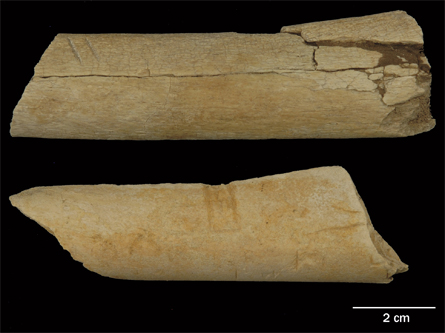Lucy’s kind used stone tools to butcher animals
African fossils bear 3.4-million-year-old traces of tool-using carnivores.
For Lucy and her ancient hominid comrades, raw meat sliced off animal carcasses was what’s for dinner. That’s the implication of a new study, published in the Aug. 12 Nature, describing butchery marks made by stone implements on two animal bones from about 3.4 million years ago.

If the new analysis holds up, it provides the oldest known evidence of stone-tool use and meat eating by members of the human evolutionary family. It’s also the first sign of such behavior in hominids preceding the Homo lineage, say anthropologist Shannon McPherron of the Max Planck Institute for Evolutionary Anthropology in Leipzig and his colleagues.
McPherron’s group made the discovery in Ethiopia’s Dikika research area. Study coauthor Zeresenay Alemseged of the California Academy of Sciences in San Francisco previously unearthed a 3.3-million-year-old skeleton of an Australopithecus afarensis child at Dikika (SN: 9/23/06, p. 195).
There’s no way to know whether the Dikika bones display marks made by intentionally produced stone tools or by sharp rocks found on the landscape. Until now, the oldest animal bones bearing stone-tool butchery marks came from another Ethiopian site, Bouri, and dated to 2.5 million years ago (SN: 4/24/99, p. 262). Researchers found the oldest known stone tools, estimated to be 2.6 million to 2.5 million years old, at nearby Gona, Ethiopia. Those implements were carefully fashioned from select types of rock, suggesting that stone toolmaking had begun much earlier (SN: 4/17/04, p. 254).
Most scientists suspect that an early Homo species made and used stone tools at Bouri and Gona. A long-standing hypothesis holds that meat eating enabled by stone implements rapidly spurred Homo evolution after 2.5 million years ago, especially brain enlargement.
“Our finds show that meat eating began much deeper in time and did not lead immediately to the origins of the genus Homo and associated biological changes, particularly larger brains,” McPherron says.
A. afarensis — best known for Lucy, a 3.2-million-year-old partial female skeleton excavated in Ethiopia in 1974 — now assumes the mantle of oldest known carnivorous wielder of stone tools. Lucy’s kind lived in East Africa from about 4 million to 3 million years ago. Only A. afarensis fossils have been found at Dikika.
No evidence of hunting or fire use exists for Lucy’s species. Her kind must have competed with other scavengers to salvage meat from animal carcasses, McPherron proposes.
The new finds add to growing evidence that A. afarensis behaved in relatively advanced ways, archaeologist David Braun of the University of Cape Town in South Africa remarks in a comment published in the same issue of Nature. Lucy’s kind had fingers short enough to manipulate stone tools and a humanlike ribcage that would have accommodated a digestive tract capable of processing large amounts of meat (SN: 7/17/10, p. 5).
Archaeologist Alison Brooks of George Washington University in Washington, D.C., says the Dikika fossils provide preliminary support for her view that ancient primates employed stones as tools even before the origin of hominids around 7 million years ago. Brooks notes that modern chimpanzees and capuchin monkeys use stones to crack nuts (SN: 11/21/09, p. 24).
Stone toolmaking began earlier than 2.6 million years ago, in her view. Abundant stone artifacts at Gona reflect a move toward large-scale tool production at special sites, Brooks posits.
McPherron’s contention that Lucy’s kind used stones to cut meat off animal carcasses “seems plausible, but the case isn’t proven yet,” remarks archaeologist John Harris of Rutgers University in New Brunswick, N.J.
Next year McPherron’s team will expand its search for stone tool–modified bones at Dikika.
One of the bones described in the new report, a rib fragment, comes from a cow-sized mammal. The other bone comes from the upper leg of a goat-sized mammal. These fossils lay between volcanic deposits previously dated to 3.24 million and 3.42 million years ago, but are much closer to the older deposit.
Scanning electron microscopy indicated that sharp-edged stones had created incisions on the bones. Chemical analysis of bone surfaces showed that incisions had been made before fossilization occurred.
Cutting and scraping of meat yielded a distinctive pattern of cuts on both bones, McPherron’s team asserts. One indentation contained a tiny, embedded piece of rock that likely chipped off a meat-cutting tool. Additional damage on the leg fossil resulted from hammering with a large stone, probably to obtain nutrient-rich marrow inside the bone.
Whether Lucy’s kind made stone tools or collected sharp stones, they would have had to go 6 kilometers, or 3.6 miles, west of Dikika to find rocks suitable for butchering carcasses, McPherron says.
Transport of stones across that distance suggests to Braun that “the meat and marrow of large animals must have been a valued resource.”







